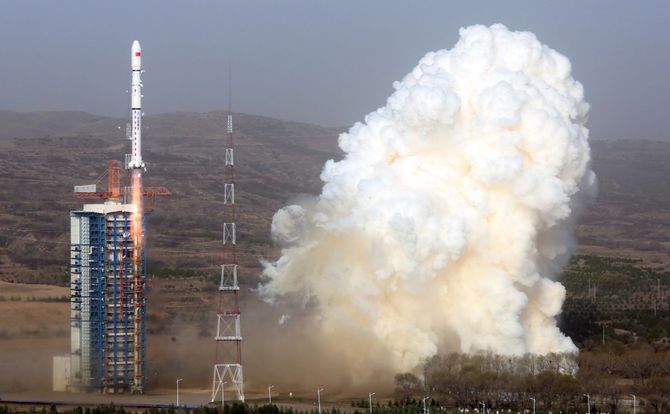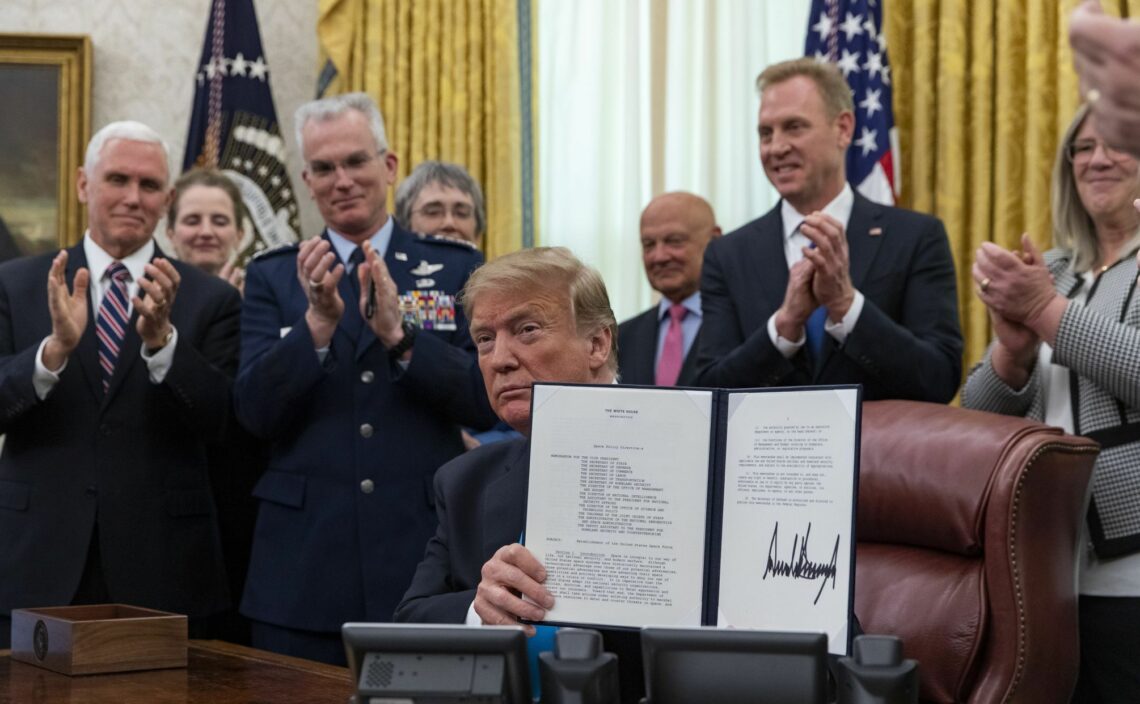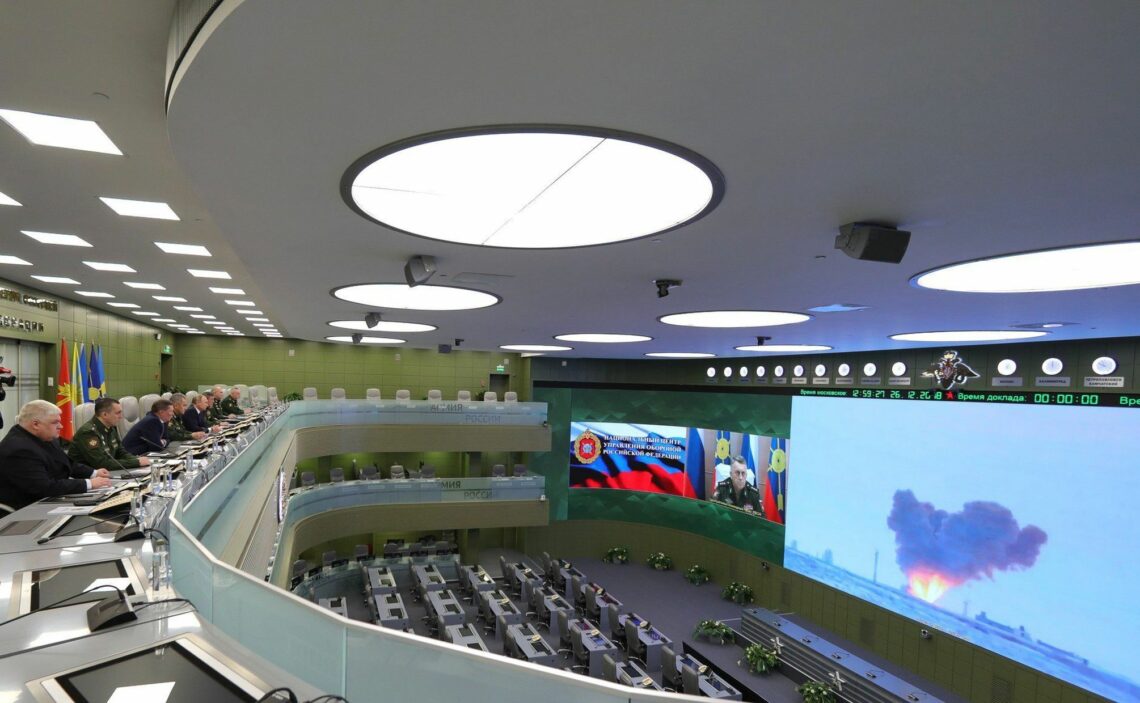The militarization of space: separating the hype from the real risks
Since the re-establishment of the U.S. military’s Space Command, plenty of ink has been spilled on the potential for space-based weapons. However, the battle for dominance in space will remain earthbound. The question is whether the U.S., Russia, and China afford the advanced research necessary to gain an edge over each other.

In a nutshell
- As great-power rivalry moves into space, costs are skyrocketing
- Sustaining the advanced research required to develop weapons will be key
- Russia’s bravado suggests it may have trouble, while the Chinese remain quiet
- The U.S. may be escalating the race to try and outspend its less-rich adversaries
In December 2018, President Donald Trump announced the formation of a sixth branch of the United States Armed Forces – the Space Command. Rumors that he would do so had abounded for some time, so it was not a major surprise. Nor is it clear that the decision will have much of an impact outside bureaucratic turf wars. After all, the U.S. first introduced the Space Command back in 1985; it was disbanded and transferred to the Strategic Command in 2002. President Trump’s decision to revive it is more of a political move than a serious military development. Unsurprisingly, however, it has provoked angry reactions from the Kremlin.
When the notion was first floated by the White House in June 2018, the Kremlin threatened a “tough response” without a hint of irony, even though Russia had already introduced its own space force in 2015. At stake here is prestige, more than military capability. The Russians took particular issue with a subsequent statement by Vice President Mike Pence, in August 2018, that the U.S. must have “dominance in space.”
It is tempting to speculate on a scenario of the militarization of space that entails fanciful imagery of James Bond and Star Wars, of Death Stars and killer satellites. Given that space is developing into a serious frontier for great power competition, it is admittedly not entirely unrealistic. With all sides dependent on the variety of satellites that are orbiting the earth, there are grounds for concern that a military conflict might open with crippling strikes against the enemy’s “eyes and ears” in space.
Back to earth
American defense planners are concerned. Both Russia and China are developing weapons that may soon be able to take out U.S. satellites. In 2007, China launched a missile that tracked and destroyed one of its own satellites, leaving a mass of debris in its wake, and in 2014 it fired an anti-satellite (ASAT) kill vehicle. Both demonstrated the ability to maneuver satellites at low speed, close to other satellites. In March 2015, a Russian military satellite made up to eleven close approaches to the upper rocket stage that lifted it into orbit. And all sides are busy developing laser weapons.
For years to come, the battle for dominance in space will use earthbound technology.
Perhaps the future will indeed entail a U.S. space force armed with the “laser battalions in space” featured in President Ronald Reagan’s 1983 Strategic Defense Initiative (SDI), colloquially known as “Star Wars,” to build a missile defense shield in space. But this is hypothetical, and getting overly excited about the introduction of space forces can be seriously misleading. For years to come, the battle for dominance in space will take place using earthbound technology such as ground-based lasers and ASAT missiles.
Although satellites will play an important role, both long-range radars and missile launchers will remain based on earth. Advances in the development of supersonic cruise missiles that fly below radars may increasingly displace the strategic ballistic missiles.
What the media hype about the militarization of space gets right is that as great power rivalry moves into space, it is not only the missiles that skyrocket – so do the costs. The key feature in any discussion of a pending “space race” must therefore concern who can better sustain the wager on the advanced research and development that will be needed for technological breakthroughs.
Money and brains
Brute economic power is an important factor. During the Cold War, the USSR managed to keep up with the U.S. in the arms race by devoting a disproportionate share of gross domestic product (GDP) to the military. By some measures, the Soviet Union spent six to seven times more on the military than did the U.S., as a share of GDP. Some have also argued that President Reagan’s threat of “Star Wars” was instrumental in bringing an end to the Cold War, simply by spooking the Soviet leadership.

Russian President Vladimir Putin is faced with an even more complex challenge than the one faced by Mikhail Gorbachev, the last Soviet leader. Given the Russian economy’s diminutive size compared to those of the U.S. and China, the Kremlin is at a serious disadvantage. But it is not only a question of economic resources. Spending money will only provide results if there is a solid platform of basic research that can turn that funding into cutting-edge military technology.
The Pentagon is rightly concerned that China is closing in on the advantage long enjoyed by the American educational and research establishment. As elite Chinese universities climb in international rankings, and as large numbers of Chinese students enroll and conduct research at top American technical universities like the Massachusetts Institute of Technology and the California Institute of Technology, the Chinese military will continue to have intellectual resources that outstrip Russia’s. A scenario of the Middle Kingdom overtaking the United States in military-space technology is now a distinct possibility.
During the 1990s, China was dependent on Russia for the development of air defense and air superiority fighters, and its space program was in its infancy. Today, how much longer it will need Russian suppliers is an open question. Despite plenty of hype, in 2015 Russia only managed to sell 24 of its latest Su-35 fighter jets, raising fears that China had already absorbed the technology transfer it needs. China’s upcoming J-11D fighter is expected to match or even surpass the Su-35. Some have also claimed that the recently introduced Chinese fifth-generation J-20 fighter is superior to the much-vaunted Russian Su-57. China’s engineers have surged ahead of Russia’s in developing aircraft with electronically scanned array radars and next-generation air-to-air munitions.
Bravado game
The counter-scenario for Russia is a complex mixture of political grandstanding and retention of serious technological niches. President Putin has allocated substantial resources to military revival, seeking to ensure that the Russian armed forces regain their former position, equal to the U.S. adversary. Reflecting the contrast between technological prowess and rhetoric, the results to date have impressed some and been derided by others as a mere facade.
‘No one has listened to us. You listen to us now.’
Important support for the latter interpretation is provided by the Kremlin’s obvious need to advertise that it is still in the race, is still dangerous and must not be ignored. China, in contrast, appears to feel so secure in its own rapid development of military and space technology that it can look with condescension on Russia’s bravado.
In his state of the nation address in March 2018, Mr. Putin was fiercely assertive, claiming that Western sanctions and other attempts to contain Russia had failed. “All what you wanted to impede with your policies have already happened,” he said. To back up this claim, he gave a multimedia presentation showing six new superweapons.
Included were the RS-28 Sarmat intercontinental ballistic missile (ICBM) and the Avangard hypersonic glide vehicle, both of which have already flown. More fanciful were a nuclear-powered unmanned underwater vehicle dubbed Poseidon (formerly Status-6, NATO reporting name Kanyon) that can dive to extreme depths and deliver nuclear charges to the North American coast; an unnamed nuclear-powered cruise missile that would have almost unlimited range; an air-launched hypersonic cruise missile named Kinzhal that can carry both nuclear and conventional warheads; and a short-range directed-energy system resembling the U.S. Navy’s AN/SEQ-3 Laser Weapon System.
The main message of the presentation was one of sharp defiance: “No one has listened to us,” Mr. Putin declared. “You listen to us now.”
Russian challenge
Looking beyond the bravado, the key factor is the levels of advanced technology, and therefore of escalating costs, that are involved in developing the new weapons. Based on current military and space technology, Russia very clearly remains in the race and may be a serious contender in the longer term. The challenge for the Kremlin lies in meeting the escalating costs of a “space race,” and in sustaining the cutting-edge basic research that once marked the USSR.

Pride of place on the Russian side goes to the huge R-26 Sarmat ICBM. Able to carry multiple warheads (MIRV), it has been touted by the Kremlin as capable of defeating any missile defense system. Given that the U.S. is still developing its missile defense systems, this statement may seem a bit premature. More importantly, as with Star Wars, experts are divided on whether missile defense would really work. Given that an ICBM will reenter the atmosphere at speeds of Mach 20 or more, the task of defeating it has been likened to hitting a bullet with a bullet.
The Avangard takes this challenge to an even higher level. Carried into the atmosphere near to space on top of an ICBM, the missile will detach and glide toward its target at extremely high speed. It has reportedly reached Mach 27 in flight tests. Cruising close to (but not quite in) space, it will fly too low for detection by long-range early warning radars yet too high to be hit by endo-atmospheric interceptors. Its alleged ability to take evasive maneuvers on final approach adds to its lethality. According to President Putin, the Avangard is “absolutely invulnerable to any missile defense system.”
There is reason for defense planners to worry. Unlike supersonic weapons, hypersonic weapons travel at more than five times the speed of sound, presenting an awesome challenge to defense systems. Hypersonic weapons that are capable of maneuvering on final approach may not only penetrate strategic missile defenses, but may also whiz past the outer defenses of aircraft carrier groups, rendering the iconic symbol of U.S. naval might obsolete.
It is not surprising that the Pentagon is responding to the Russian challenge by developing a program of “counter-hypersonics.” The Defense Advanced Research Projects Agency (DARPA) is busy developing a program called Glide Breaker to intercept incoming hypersonic glide vehicles. Whether it would work is perhaps not the main issue. The strategic advantage is to create insecurity, to deter attack by raising doubt about how many missiles would reach their targets.
This is the military research frontier. It is not a space race, but a race of basic research, in which the winner will be whoever can best combine resources and brains to achieve breakthroughs. Given that China is generally recognized to be on the verge of catching up to the U.S., the essential question is whether the Russian educational and research establishment can live up to the implied demands.
China vs. Russia
In China, the increasingly repressive nature of the regime of President Xi Jinping could throttle the pace of technological advance, which so far has looked certain to catch up with the U.S. and leave Russia in the dust. Aggressive industrial espionage policies are leading to repercussions for high-tech companies like Huawei, and intellectual isolationism in banning Google, YouTube, Facebook and virtual private networks (VPNs) will have a negative impact on scholarship. Complaints from universities about internet restrictions have not made any obvious impression.
President Putin’s rush development of new weapons conflicts with his nationalistic ambitions.
Russia does retain some areas of unquestionable superiority. It is still possible that China will purchase large numbers of the Su-35 “generation 4+++” fighter, and the fifth-generation Su-57 does have capabilities (such as three-dimensional thrust vectoring engines) that China still has to master. If Beijing fails to maintain its tempo of high-tech development, Moscow may have some muscle left for sales – both to China and to vital third markets – and thus for additional advances.
The problem for the Kremlin is that President Putin’s rush development of fancy new weapons conflicts with his nationalistic and isolationist ambitions. Placing heavy priority on military expenditure at a time of severe fiscal pressure will have a negative long-term impact on education, creating hardship for senior researchers. Protecting the regime by defining foreign partners as “foreign agents” will discourage academic cooperation with elite Western universities.
In contrast to the path taken by China, Russia is retreating into isolation. It has few highly-ranked universities and a poor track record of commercializing military research. It has a culture of corruption that prevents large contracts from being awarded to the most competent contractors, resulting in a series of failed missile test launches. Moreover, it has developed a social climate that makes instant enrichment a top priority, causing bright young people to take up banking and finance rather than the hard sciences.
When then-President Dmitry Medvedev visited the U.S. in 2010, he was taken on a tour of Silicon Valley. Despite his modern, technology-conscious public image, it is questionable if he really understood that Silicon Valley is not about geography but about a culture that promotes innovation. The poor performance of the Russian imitation he established – the Skolkovo Innovation Center – proves this point.
The Soviet Union did produce trailblazing basic research, and by consequence was able to develop cutting-edge military technologies. But the times when countries could effectively conduct such research in isolation have passed. That modern scholarship thrives on international exchange was brought home when the Russian-born physicist Andre Geim, who resides in the United Kingdom, won the 2010 Nobel Prize in Physics.
After being invited to return to Russia to join Skolkovo, his response was that while the Kremlin could throw money at science, research would still be stymied by corruption, red tape and a lack of the international teams and facilities needed to do groundbreaking work. Asked what it would take for him to return to Russia, his terse answer was: “Reincarnation.”
Moreover, all this occurred during the “openness” under President Medvedev, well before President Putin embarked on insulating his country from outside influence. It is little wonder that his recent grandstanding on Russian superweapons had many observers shaking their heads in disbelief.
U.S.: innovative research
The longer-term scenario for the United States rests on developing its superiority in research and development. The main point with programs like Glide Breaker is that they provide multibillion-dollar opportunities for U.S. defense contractors to pursue innovative weapons research. Space will clearly figure prominently here. By escalating the hypersonic race into “counter-hypersonics,” the U.S. may well repeat the success of President Reagan in presenting the Kremlin with such frightening cost escalation that it will simply be forced to give up.
Offense will remain the best defense.
A more immediate concern is the use of high-precision nonnuclear weapons that can take out hardened bunkers and silos hitherto believed to be safe from anything but nuclear strikes. Even conventional warheads may not be needed. The kinetic energy alone of a missile striking at more than Mach 20 would be quite awesome.
A key factor is the American Prompt Global Strike program, which promises precision attacks anywhere around the globe within an hour. Increasing accuracy in targeting makes delivery of small nonnuclear weapons preferable to delivery of massive nuclear warheads. As this will blur the line between nuclear and conventional war, it will erode Russia’s nuclear deterrence and further expose its conventional weaknesses.
Offense will remain the best defense. The U.S. nuclear triad already has adequate survivability to provide deterrence against nuclear attack. Ongoing developments in both the Navy and the Air Force will enhance this ability, from a modernized fleet of nuclear-powered ballistic missile submarines (SSBNs) to the B-21 Raider Stealth bomber and the Long-Range Standoff nuclear-tipped cruise missile. From this perspective, the fancy Russian Avangard is just another extremely expensive strategic weapon, to be countered with other strategic weapons rather than with missile defense.
The remaining question for U.S. defense planners – far more important than space dominance – is whether Chinese advances in supersonic, over-the-horizon anti-ship missiles will be enough to deter U.S. carriers from approaching Chinese waters. The answer to that question is likely affirmative.







